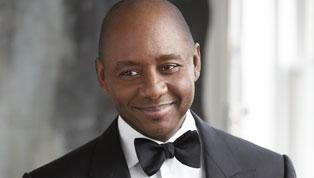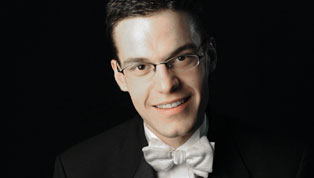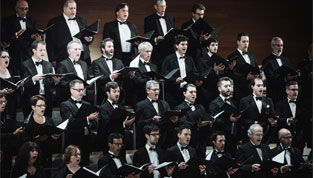FROM BACH TO REGER:
THE GERMAN ORGAN
SEASON PARTNER
Maison symphonique de Montréal
TICKETS PRICES
8:00 PM
Christian Schmitt
Organ
PROGRAM:
Merkel, Variations on a Theme by Beethoven (op. 109) (approx. 18 min.)
J. S. Bach, Fantasia and Fugue in C minor, BWV 537 (approx. 10 min.)
Widor, Organ Symphony no 6, op. 42, no 2 (excerpt): I. Allegro (approx. 10 min.)
Mozart, Adagio and Allegro in F minor, K. 594 (approx. 11 min.)
Hosokawa, Cloudscape (approx. 7 min.)
Reger, Fantasia and Fugue on “Wie schön leucht uns der Morgenstern” by J. S. Bach, op. 40 (approx. 18 min.)
CONCERT NOTES
The German organ repertoire is largely dominated by the figure of Johann Sebastian Bach. Not only did the “Cantor of Leipzig” succeed in a synthesis of the various schools of organ performance of his own time, but traces of his legacy are found in generations of musicians that followed. Countless have analyzed and performed his works, whether as models of contrapuntal writing, or as skillfully constructed, expressive creations. Bach’s influence amongst the composers on this programme contributed to the forging of their musical personalities, while representing an eternal source of inspiration.
GUSTAV ADOLF MERKEL
Born in Oderwitz, Germany, November 12, 1827. Died in Dresden, October 30, 1885.
Variations on a Theme by Beethoven, Op. 45
There is no better way of getting to know an instrument than through variations on a theme: in the organist’s case it is the chance to display the entire sonic palette at his or her disposal. The composer of Variations on a Theme by Beethoven inscribed several registration indications on the score, allowing the performer a certain freedom of choice. Behind this work stands a an unjustly forgotten composer. He was a great defender of the music of Bach, produced nine sonatas for organ, works for piano and choral music. His long career as an organist made him a specialist in the instrument, whence his organic style of writing.
JOHANN SEBASTIAN BACH
Born in Eisenach, March 31, 1685. Died in Leipzig, July 28, 1750.
Fantasia and Fugue in C minor, BWV 537
Bach may have composed the Fantasia and Fugue in C minor near the end of his Weimar period (around 1716), while he was organist at the chapel of Duke William II, or perhaps around 1723 while he was kapellmeister at Köthen – specialists can’t agree. Nonetheless, the work employs all the expressivity implied by its key of C minor. Beginning with a tone of gravity, the first measure features a low C on the organ’s pedals. First heard alone, it soon takes on the supporting role to a supplicant soprano voice, which is then retaken in other registers. Notably, this fantasia ends with a half cadence: the ending is inconclusive, pausing only to introduce the subject of the fugue. In a much less sombre character, the fugue highlights from its very beginnings the pivotal notes in the key of C minor (C and G).
CHARLES-MARIE WIDOR
Born in Lyon, February 21, 1844 – Died in Paris, March 12, 1937.
Organ Symphony No. 6, Op. 42, No. 2 (excerpt): I. Allegro
Rare is the professional organist who has not confronted the challenges of the Widor symphonies. By turns flamboyant and expressive, these vast works require as many resources from the instrument itself as they do from the performer. Though Widor was born outside of the Germanic territories, he was nonetheless well-acquainted with the music, relying heavily on the influence of Bach. Moreover, in using the title “symphonies” for his grand organ suites, he created a link to the German symphonic tradition. Of the ten symphonies that the Saint-Sulpice organist composed, Symphony no. 6 is one of the most played. Its popularity rests largely on the majestic character of its first movement, marked Allegro. After the opening procession, a recitative punctuated by dramatic chords creates a striking effect. A series of variations follows, each one more virtuosic than the last. Through the music one can imagine the exaltation felt by the audience at the work’s premiere on August 24, 1878, at the inaugural concert of the Trocadéro Palace organ.
WOLFGANG AMADEUS MOZART
Born in Salzburg, January 27, 1756. Died in Vienna, December 5, 1791.
Adagio and Allegro in F minor, K. 594
Around 1780, a Viennese count named Joseph Deym-Müller opened a cabinet of curiosities, which he enjoyed exhibiting to the accompaniment of a pipe organ, but without the intervention of a human performer. The “machine” he featured consisted of a series of organ pipes connected to a clock mechanism. The automaton would play music determined by rolls covered in small points at regular intervals during the day. Additionally, the count wished to honour the memory of the admired Baron Von Lauden, whose tomb was featured in the middle of the cabinet. It was thus that he commissioned the Adagio and Allegro in F minor from Mozart – a specially composed work, which was completed in 1790. Despite the suggestion of its title, the work is in three movements, the last consisting of a reprise of the opening Adagio.
TOSHIO HOSOKAWA
Born in Hiroshima, October 23, 1955.
Cloudscape
Hosokawa’s name has become well-known in contemporary music. A prolific composer trained in Tokyo and Berlin, he was recipient of several important honours over his career: in addition to having founded a contemporary music festival in Japan in 1989, he was named composer in residence of the Tokyo Symphony Orchestra and member of the Berlin Academy of Arts in 2001. In Cloudscape, first performed in July 2003 in Avignon, Hosokawa evokes the sound of the shô, a traditional Japanese mouth-organ. The feet and the hands of the organist represent three distinct shôs, sometimes playing independently, sometimes converging, creating troubling harmonies. The title suggests the possibility of leaving our familiar soundscape in favour of a universe in suspension. A feeling of weightlessness permeates the first moments, with the superposition of layers of sound in the high registers of the keyboard, separated at first by long silences, then accumulating in ever more dense masses. The addition of different organ stops and the thickening of the masses, now sounding in the lower registers, darken the atmosphere. But this stormy moment dissipates as the serenity of the finale returns: at the end, one singular note shines through, unencumbered by the surrounding sounds, before the music evaporates completely.
MAX REGER
Born in Brand, Bavaria, March 19, 1873. Died in Leipzig, May 11, 1916.
Fantasia and Fugue on “Wie schön leucht uns der Morgenstern” by J. S. Bach, Op. 40, No. 1
Max Reger’s organ works were not intended for beginners. They are characterized by a full and complex style of writing. Following Bach, Reger would elaborate vast canvases, often in the form of diptychs (Prelude and Fugue or Fantasia and Fugue), in which the counterpoint achieved an unequalled degree of complexity, and virtuoso figuration abounded in all parts. Such is the case in the Fantasia and Fugue on «Wie schön leucht uns der Morgenstern” (How lovely shines the morning star), a hymn sung on the feast of Epiphany in Lutheran churches since the 17th century. According the organ specialist Michel Roubinet, the choral was “understood by Reger not only as referring to the childhood of Christ, but as the prolongation of his earthly life on his return after Judgement.” The result is a grandiose work, whose theme, like the text that inspires it, shines like a star, “full of the grace and the truth of the Lord.”
mina Burana ends with a stern warning:
© Hélène Panneton pour Le Trait juste
English translation by Marc Wieser
THIS CONCERT SERIES: RECITALS
YOU WILL ALSO LIKE
* Prices, artists, repertoire, and, concert dates and times may be modified without notice.
Prices include a non-refundable service fee of $9.00 per ticket. Some handling fee may be charged.



